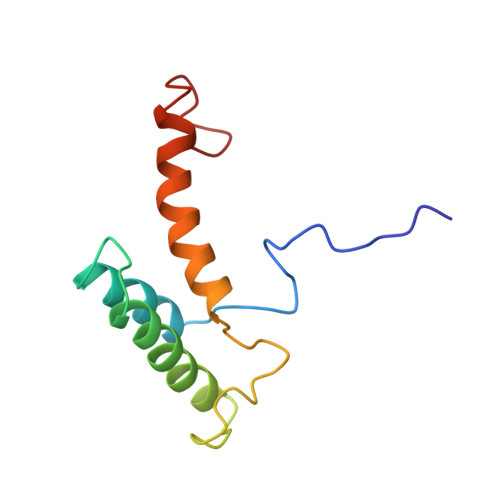The NMR solution structure of the non-classical homeodomain from the rat liver LFB1/HNF1 transcription factor.
Schott, O., Billeter, M., Leiting, B., Wider, G., Wuthrich, K.(1997) J Mol Biol 267: 673-683
- PubMed: 9126845
- DOI: https://doi.org/10.1006/jmbi.1997.0905
- Primary Citation of Related Structures:
2LFB - PubMed Abstract:
The nuclear magnetic resonance (NMR) solution structure of the non-classical homeodomain from the rat liver LFB1/HNF1 transcription factor was determined with the program DIANA from an input of 1356 nuclear Overhauser enhancement (NOE) upper distance constraints and 228 dihedral angle constraints collected using experiments with the unlabelled, the uniformly 15N-labelled and the uniformly 13C-labelled protein. Out of a group of 50 independently calculated conformers the 20 conformers with the smallest residual DIANA target function values were refined by energy minimization with the program OPAL and are used to represent the NMR structure. The average of the pairwise root-mean-square deviations (r.m.s.d.) of these 20 individual NMR conformers relative to the mean coordinates is 0.73 A (1 A = 0.1 nm) for the backbone atoms N, C(alpha) and C' of residues 15 to 82. The chain-terminal polypeptide segments 1-14 and 90-99 are disordered in solution. The globular fold contains three well-defined helices comprising the residues 19 to 29, 37 to 53 and 71 to 81, and the third helix is extended by a less well-ordered fourth helix with residues 82 to 89, which coincides with corresponding observations in "classical" homeodomains. Side-chain analysis resulted in 33 "best-defined" side-chains, with global displacements smaller than 1.1 A, and addition of these side-chains to the global superposition of residues 15 to 82 resulted in a r.m.s.d of 0.81 A. The protein contains two hydrophobic cores, one of which corresponds to the helical packing seen in classical homeodomains, while the other one stabilizes the conformation of the 21-residue insertion between helices II and III. The individual helices and their relative spatial arrangements are stabilized by a variety of structural motifs, which include medium-range and long-range hydrogen bonds and salt bridges. Detailed comparison with the Antennapedia homeodomain, and studies of the complex formation with an operator DNA half-site provided initial information on the DNA-binding mode of the LFB1/HNF1 homeodomain.
Organizational Affiliation:
Institut für Molekularbiologie und Biophysik, Eidgenössische Technische Hochschule-Hönggerberg, Zurich, Switerland.














